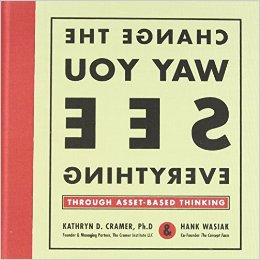Back to Teens
Change the Way You See Everything
This week, I read the book Change the Way You See Everything through Asset-Based Thinking by Kathryn D. Cramer, Ph.D. and Hank Wasiak. Interestingly, I was assigned to read it for a course in my Education, Inquiry & Justice minor. At first, I was a little confused why a self-help book had been assigned in school, and how it would be relevant to the class. So far I haven’t heard of our book, Communication Skills for Teens, being used in a classroom, but that would be pretty cool!
I came to understand why it was applicable to what we’re working on in my class, but here I’d like to focus on its impact on me personally. I especially want to talk about how it relates to communication skills we highlight in our book. Both books give readers tools for success in the way that they approach themselves, others, and situations.
So, this book presents the approach called asset-based thinking. Asset-based thinking encourages us to focus on goals, resources, and things we see to be valuable. However, the author is not saying that everything is good and there are no negatives. Asset-based thinking shows how the glass can be simultaneously “half-empty” and “half-full.” It helps us be less critical and more curious about how to overcome challenges.
Asset-based thinkers don’t say, “Why didn’t I do this?” Instead, they say, “What can I do better next time?” It’s not about pretending that you didn’t mess up or that something wasn’t wrong, but it’s about being proactive and looking for positive motives in negative action.
The book is split up into three sections associated with yourself, others, and situations. The author explains how engaging in asset-based thinking in these three areas can help you counteract obstacles.
- Change the way you see yourself
The key presented here is “Magnify what’s best, focus on what’s next.”
One exercise that had to do with changing the way you see yourself through asset-based thinking that I appreciated was the Morning Mental Workout.
Begin each day with a mental workout. Coach your first thoughts to be strong, clear, encouraging. This morning routine will keep you from wanting to roll over and go back to sleep. It is a vivid dress rehearsal that shapes what you aim for and how you respond to what comes your way. Review your most important objectives by completing the following sentence: “I am perfect person to accomplish ___________ (describe your objective) because I am/have ___________ (describe your assets).”
The book talks a lot about the importance of vision and that really resonated with me. If I start out my day with a confident vision, then I am more likely to believe that I can do it and am probably more likely to actually accomplish it, too!
- Change the way you see other people
The key in changing the way you see others is to utilize “positive filters.”
My favorite part in this section explained how to use asset-based thinking to give constructive feedback.
-
State the behavior that bothers you clearly and concisely.
-
State the impact of that behavior on you and the relationship.
-
Present the positive vision you have to resolving the conflict or disruptive interactions. (This will set the tone of your listener’s action)
Here, the idea of vision comes back into play! It’s so important to talk about how to move forward when discussing a problem. Being proactive will always result in a better outcome. I can see using this model for constructive feedback with my siblings, parents, friends, significant others, and co-workers.
These steps for constructive feedback complement the skills we discuss in our book. In particular, it would be great to check out Chapter 1 on listening skills to help you in an interaction like this one. Knowing how to listen is just as important as knowing what to say!
- Change the way you see situations.
The key to changing the way that you see situations is to “widen your lens.”
Asset-based thinkers see problems as pauses, and think (…) not (.) This means that you don’t get stuck. Instead, you look forward when you face a challenge. You ask yourself and those around you “How can this be the best problem we’ve ever had?” I think that is such a cool question.
I would encourage you to check out the book if any of this sounded like it would be helpful for you. I’m glad I had to buy it for school because now I have it as a resource for my personal life, too.
